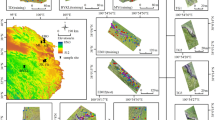Abstract
Nature inspired intelligence is increasingly being used to solve complex problems. Identifying different types of terrains present in the satellite imagery of a given region is one such problem in the field of remote sensing. Prospects of its numerous applications in real life have been a motivating factor for scientists to develop newer terrain analyzers to perform this task with more precision. This paper presents a two phase biogeography based optimization (BBO) based generic frame work for identifying natural terrain features in a given region. BBO is a population-based algorithm and is based on the theory of island biogeography that explains the geographical distribution of biological organisms. Validation is performed on two remote sensing datasets for Alwar and Delhi regions in India. Better performance of proposed analyzers has been observed as compared to state of the art techniques.













Similar content being viewed by others
Explore related subjects
Discover the latest articles, news and stories from top researchers in related subjects.References
Mora AM, Fernandes C, Merelo JJ, Ramos V, Laredo JLJ, Rosa AC (2008) Kohonants, a self-organizing ant algorithm for clustering and pattern classification. In: Artificial life XI. MIT Press, Cambridge, pp 428–435
Brown M, Gunn SR, Lewis HG (1999) Support vector machines for optimal classification and spectral unmixing. Ecol Model 120(2):167–179
Chen K, Tzeng Y, Chen C, Kao W (1995) Land-cover classification of multispectral imagery using a dynamic learning neural network. Photogramm Eng Remote Sens 61(4):403–408
Lu D, Weng Q (2007) A survey of image classification methods and techniques for improving classification performance. Int J Remote Sens 28(5):823–870
Simon D (2008) Biogeography-based optimization. IEEE Trans Evol Comput 12(6):702–713
Simon D, Ergezer M, Du D (2009) Population distributions in biogeography-based optimization algorithms with elitism. In: IEEE conference on systems, man, and cybernetics, pp 1017–1022
Dunn Joseph C (1973) A fuzzy relative of the ISODATA process and its use in detecting compact well-separated clusters. J Cybern 3(3):32–57
Fernandes C, Mora AM, Merelo JJ, Ramos V, Laredo JL, Rosa AC (2008) KohonAnts: Artifical Ant System for Classification. ANTS Conference, pp 339–346
Foody G Neural Networks in Remote Sensing. Scope, techniques and applications, vol 460
Foody GM (1996) Approaches for the production and evaluation of fuzzy land cover classifications from remotely-sensed data. Int J Remote Sens 17(7):1317–1340
Goel S, Panchal VK, Bhatnagar M (2009) Biogeography based land cover feature extraction. In: NaBIC, pp 1588–1591
Goel S, Sharma A, Panchal VK (2011) Biogeography based optimization, an evolutionary technique or a swarm based approach? In: 5th international multiconference on intelligent systems, sustainable new and renewable energy technology and nanotechnology (IISN-2011), pp 220–225
Goel S, Sharma A, Bedi P (2013) Novel approaches for classification based on Cuckoo search strategy. Int J Hybrid Intell Syst 10(3):107–116
Goel S, Sharma A, Panchal VK (2013) Performance analysis of bio-inspired techniques. In: Advances in intelligent systems and computing. SOCPROS, vol 2259
Gupta D, Das B, Panchal V (2011) A methodical study for the extraction of landscape traits using membrane computing technique. WORLDCOMP, Las Vegas, USA
Heermann PD, Khazenie N (1992) Classification of multispectral remote sensing data using a back-propagation neural network. IEEE Trans Geosci Remote Sens 30(1):81–88
Holden NP, Freitas AA (2007) A hybrid PSO/ACO algorithm for classification. In: Paper presented at the proceedings of the 2007 GECCO conference companion on genetic and evolutionary computation
Huang C, Davis L, Townshend J (2002) An assessment of support vector machines for land cover classification. Int J Remote Sens 23(4):725–749
Kennedy J, Everhart RC (1995) Particle swarm optimization. In: Proceedings of the IEEE international conference on neural networks, Perth, Australia, vol 4, pp 1942–1948
Leandro NC (2007) Fundamentals of natural computing: an overview. Phys Life Rev 4:1–36
Lila K, Grzegorz R (2008) The many facets of natural computing. In: Communication of the ACM, vol 51, no. 10
Lillesand TM, Ralph WK, Jonathan WC (2004) Remote sensing and image interpretation, 5th edn. Wiley, New York
Mather P, Tso B (2003) Classification methods for remotely sensed data. CRC Press, Boca Raton
Dorigo M, Stuetzle T (2004) Ant colony optimization. MIT Press, Cambridge
Monmarche N, Slimane M, Venturini G (1999) AntClass: discovery of clusters in numeric data by an hybridization of an ant colony with k-means algorithm. Internal Report no. 213, Laboratoired’ Informatique de l’Universite de, pp 1–21
Øhrn A, Komorowski J (1997) ROSSETA—a rough set tool kit for analysis of data. In: Proc. 3rd international joint conference on information sciences, Durham, NC
Omkar SN Manoj KM, Mudigere D, Muley D (2007) Urban satellite image classification using biologically inspired techniques. In: IEEE international symposium on industrial electronice, 4–7 June, pp 1767–1772
Paul Mather, Brandt Tso (2009) Classification methods for remotely sensed data, Second edn. CRC Press, Boca Raton
Pawlak Z (1998) Rough set theory and its applications to data analysis. Cybern Syst 29(7):661–688
Wilkinson GG (2005) Results and implications of a study of fifteen years of satellite image classification experiments. IEEE Trans Geosci Remote Sens 43(3):433–440
Yang S, Deb S (2009) Cuckoo search via Lévy flights. In: World congress on nature & biologically inspired computing (NaBIC 2009). IEEE Publications, New York, pp 210–214
Yang XS (2010) Nature-inspired metaheuristic algorithms, 2nd edn. Luniver Press, Beckington
Zadeh LA (1965) Fuzzy sets. Inf Control 8(3):338–353
Zadeh Lotfi A (1995) Fuzzy logic toolbox for use with MATLAB, vol 2, no. 38. The MATH WORKS, Berkeley, pp 109–112
Acknowledgments
We acknowledge Defense Terrain Research laboratory (DTRL) of Defense Research and Development Organization (DRDO), Delhi, India for providing the real datasets for this work.
Author information
Authors and Affiliations
Corresponding author
Rights and permissions
About this article
Cite this article
Sharma, A., Goel, S. A BBO based framework for natural terrain identification in remote sensing. Memetic Comp. 7, 43–58 (2015). https://doi.org/10.1007/s12293-015-0154-1
Received:
Accepted:
Published:
Issue Date:
DOI: https://doi.org/10.1007/s12293-015-0154-1




